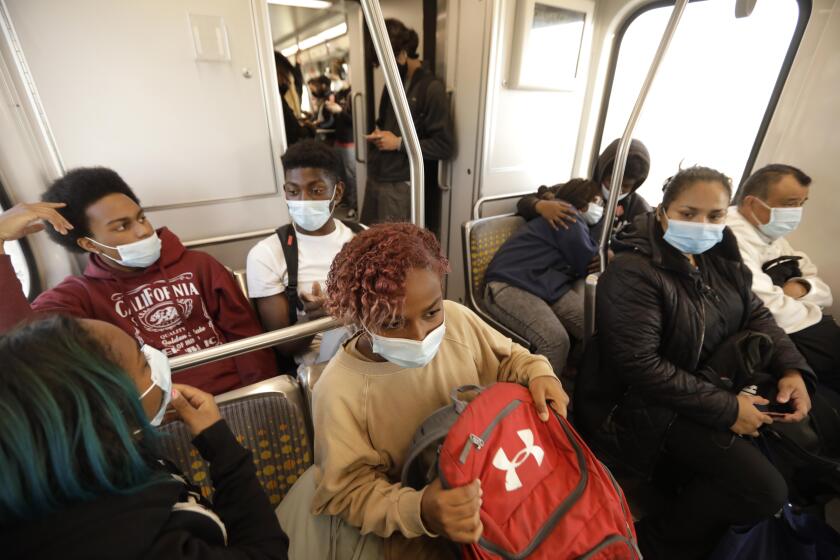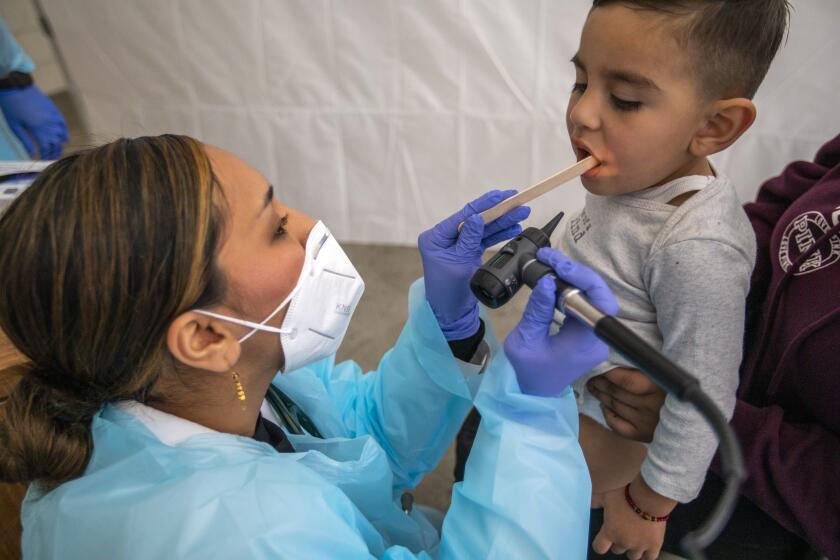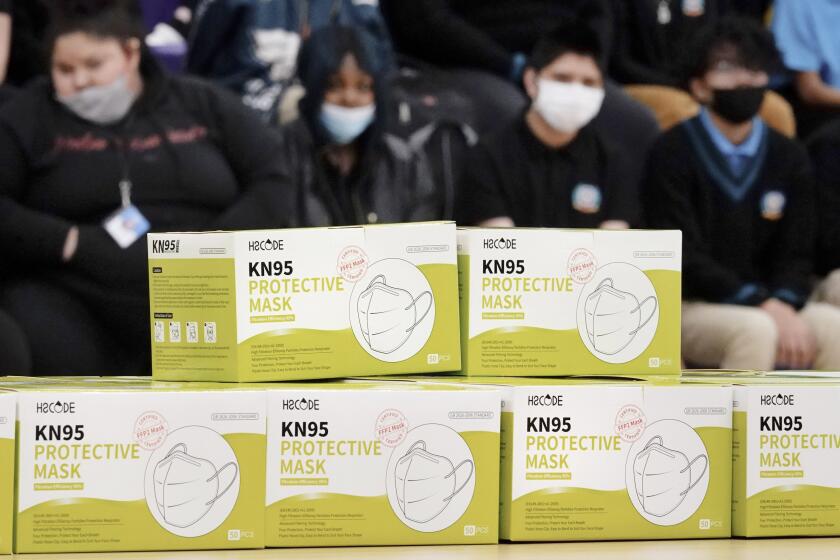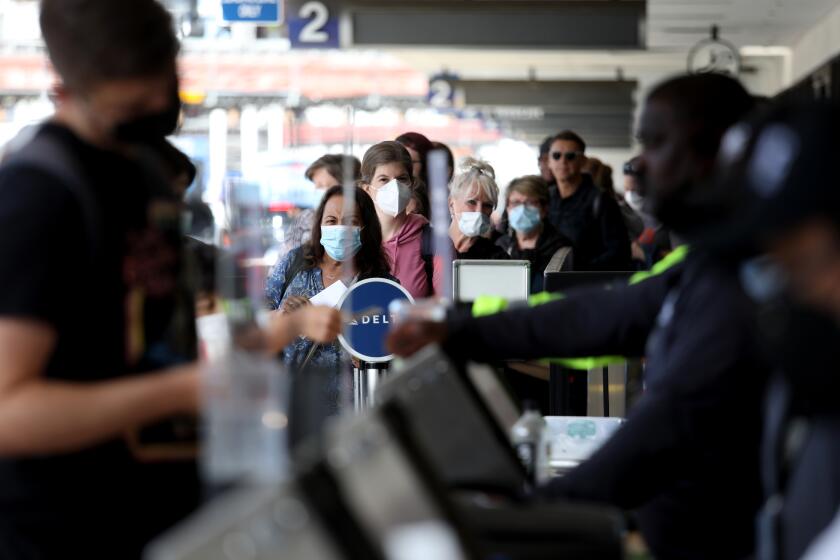L.A. coronavirus cases up 40% in one week; hospitalizations rising, too
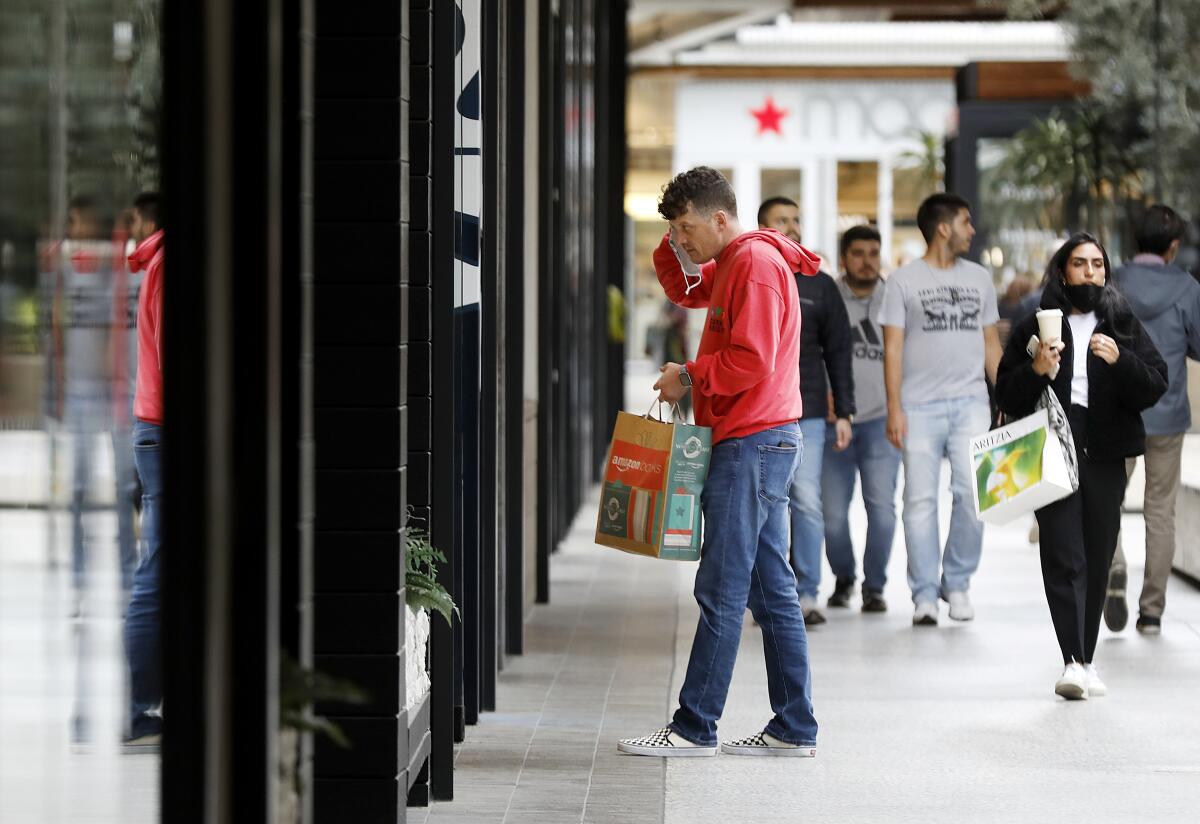
- Share via
Coronavirus cases in Los Angeles County rose by 40% over the past week and hospitalizations have started to creep up as well, underscoring how important it is for people to be up-to-date on their vaccines and boosters, as well as wear masks in indoor public settings, officials said.
Although neither the number of infections nor the patient census are setting off alarm bells just yet, the trendlines illustrate that the county is contending with reinvigorated coronavirus transmission. And for county Public Health Director Barbara Ferrer, who called the increase in cases “pretty significant,” they reinforce the importance of taking individual actions to thwart the spread.
“Since the beginning of the pandemic, we’ve all had to make choices about how to best protect ourselves and others from COVID-19,” she told reporters Thursday. “With cases on the rise, the potential for more contagious variants and lots of opportunities to be exposed, this is a great time to make a choice to get vaccinated or boosted and to wear a mask or respirator when you’re indoors and around others.”
Supt. Alberto M. Carvalho recommends that L.A. Unified push back its student vaccination mandate, a move that would align with state requirements.
Over the last week, L.A. County has reported an average of about 1,764 new coronavirus cases per day — up from 1,261 a week ago.
The latest number is double the 879 cases a day L.A. County was reporting in early April.
On a per capita basis, the county’s case rate has risen to 122 cases a week for every 100,000 residents. L.A. County’s case rate exceeded 100 over the weekend, meaning the nation’s most populous county is again experiencing a high rate of transmission for the first time since early March.
Perhaps more concerningly, the number of coronavirus-positive patients hospitalized countywide has also risen this week following months of steady decline.
On Wednesday, 249 such individuals were hospitalized countywide. Five days earlier, on Friday, the count was 209: the lowest single-day total for the county since the pandemic began, state data show.
Hospitalizations have yet to follow the path of rising coronavirus cases in California, and in fact are at near-record lows.
Since the emergence of the highly infectious Omicron variant of the coronavirus in December, officials have noted that many infections have tended to result in relatively mild illness — forging an environment where case counts were sky high, but the share of people being hospitalized with COVID-19 was lower than in the pandemic’s previous waves.
For instance, during the peak of the winter Omicron wave, 1.2% of coronavirus cases in L.A. County were hospitalized; by contrast, during last summer’s Delta wave, 5.6% of cases were hospitalized.
Nevertheless, the sheer infectivity of Omicron stretched some hospitals throughout the state to their limit. And in the months since the last surge subsided, new even-more-contagious subvariants of Omicron have emerged — including BA.2 and, more recently, BA.2.12.1.
BA.2 is the primary culprit behind the uptick in cases in L.A. County, accounting for at least 88% of cases here, officials say.
BA.2.12.1 has spawned similar increases elsewhere in the U.S., and accounts for a majority of coronavirus cases in New York and New Jersey. California officials have projected that BA.2.12.1 will also account for a majority of coronavirus cases in California within a few days, according to Ferrer.
BA.2.12.1 is estimated to be 25% more contagious than BA.2.
“With that growth advantage, it could quickly become the dominant strain across the United States,” Ferrer said.
One study found that upper airway infections among hospitalized coronavirus-infected children nearly tripled.
Ferrer said she hopes cases will stabilize fairly soon, especially if more people get vaccinated and boosted. But trends on the East Coast are concerning, where Ferrer said there is “a significant rise now in hospitalizations” and there is still much to learn about BA.2.12.1.
“So let’s continue to be cautious,” Ferrer said.
There are a number of data points that provide reason for some concern:
Wastewater: Coronavirus levels detected through wastewater surveillance have nearly doubled across large swaths of the county over a two-week period, including sewage systems that serve the city of Los Angeles and southern and eastern parts of L.A. County.
Vulnerable settings: There were 10 outbreaks at sites serving people experiencing homelessness, and six at nursing homes from April 20 to 26, an increase from prior weeks.
Workplaces: The number of worksites seeing clusters of coronavirus cases has doubled compared with the prior week. Between April 20 and 26, there were 82 worksites affected. The most common sites were in manufacturing, retail, information, food and beverage, electronics and appliance, transportation equipment and manufacturing, and the film and sound recording industries.
K-12 schools: Outbreaks are up in K-12 classrooms, and for the first time in long while, some have involved dozens of students, Ferrer said. From April 13 to 19, there were six new classroom outbreaks — all in elementary schools — and double what was seen the prior week. Ferrer says that when there are eight to 14 new outbreaks in K-12 classroom settings in a week, that’s reason for a medium level of concern.
Test positivity rates: The percentage of coronavirus tests coming back positive in K-12 settings, while remaining low, has started to increase in the past two weeks, Ferrer said. Also, “the number of [coronavirus] cases reported in students in elementary schools, middle schools and high schools more than doubled” between late March and mid-April, Ferrer said.
Three out of every four U.S. children have been infected with the coronavirus, according to new estimates from the CDC.
These clusters illustrate why health officials still strongly recommend masking while in indoor public settings, including schools.
Mask use is required on public transit and in airports in L.A. County, including Los Angeles International Airport, Hollywood Burbank Airport and Long Beach Airport. A similar mask requirement was adopted Thursday by the BART commuter rail system in the San Francisco Bay Area.
Vaccinations remain the best way to guard against severe illness and death, Ferrer said. Those vaccinated are 4½ times less likely to be hospitalized and nine times less likely to die than those unvaccinated, Ferrer said. Vaccinated people are almost two times less likely to get infected than those who aren’t.
Continuing to get booster shots also remains important, Ferrer added, because immunity from natural infection and prior vaccinations weakens over time.
“With continued circulation of easily transmissible variants, our immune systems will need to be boosted,” Ferrer said.
In addition, “people with risk factors … are at increased risk for severe disease from re-infection,” CDC scientist Dr. Kristie Clarke said at a briefing Tuesday.
A new health officer order in Los Angeles County has the nation’s most populous county again enacting face-covering rules more stringent than the state’s or nation’s.
Ferrer also urged that parents get children vaccinated. Only 32% of children ages 5 to 11 have completed their primary vaccination series in L.A. County, compared with 78% of adolescents ages 12 to 17.
By contrast, 91% of L.A. County’s seniors 65 and older have completed their primary vaccination series.
“Although most children aren’t likely to have severe illness from COVID, some do become very ill and develop long COVID,” Ferrer said. “And children are easily able to spread the virus to others and some of those other people have become severely ill.”
Otherwise healthy children are also suffering from severe COVID-19, Ferrer said, citing data that 3 out of 10 children ages 5 to 11 who were hospitalized with COVID-19 had no underlying health conditions. Nine out of 10 children in this age group hospitalized with COVID-19 were unvaccinated.
Tens of thousands of children nationally have been hospitalized with COVID-19, and more than 900 have died since the start of the pandemic. “There aren’t almost any other infectious diseases circulating in the United States that causes many children to pass away, amplifying the need for us to do everything we can to reduce this unbearable tragedy,” Ferrer said.
Even if children have already survived a coronavirus infection and develop some immunity, “we can’t predict how strong or long that protection will be,” Ferrer said. “Vaccinations … are the best and safest choice for building and protecting immunity.”
The latest maps and charts on the spread of COVID-19 in Los Angeles County, including cases, deaths, closures and restrictions.
Ferrer said the number of reported infections still remains an important indicator of where the pandemic is heading. It’s not a guarantee that the coronavirus is now destined to mainly result in milder illness, she said.
“With so many new variants cropping up, we just don’t know whether or not we’re really on this trajectory where all we’re going to see is milder and milder illness,” Ferrer said.
“And I would just suggest that we not guess on this — be overly optimistic — that we, in fact, recognize that this is a virus that mutates both fairly rapidly, but also fairly dramatically,” Ferrer said. “You don’t want unchecked transmission, which leads to the possibility of more variants of concern.”
More to Read
Sign up for Essential California
The most important California stories and recommendations in your inbox every morning.
You may occasionally receive promotional content from the Los Angeles Times.

